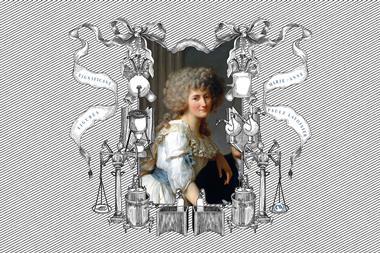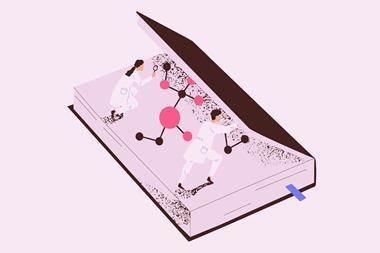Her discovery of adenine and guanine’s structure was a key part of solving the DNA double helix puzzle – yet her contributions are almost forgotten
‘I’m just surprised by people showing any interest in me whatsoever,’ 97-year-old June Lindsey said in a 2019 interview with filmmaker Amanda Raymond.
It had been seven decades since Lindsey completed her doctoral research at the University of Cambridge in the UK. During that time, she had solved the structures of adenine and guanine – two of the four DNA nucleobases. Her meticulous descriptions of the molecules’ bond length, angles, tautomerism – and especially hydrogen bonds – played a crucial part in one of the biggest scientific discoveries of the 20th century: the structure of DNA.
‘I think that it could be argued that her work was as a sine qua non – without which would not be possible the DNA structure,’ says Alex MacKenzie, a professor of paediatrics at the University of Ottawa in Canada who first met Lindsey at a family birthday party and wrote an article about her in 2018. Nevertheless, Lindsey’s name rarely features in the countless stories told about the double helix’s discovery – and she herself seemingly passed off her accomplishments as ‘simply doing her work’.
June Lindsey was born June Broomhead in a small village outside Doncaster, UK. At her all-girls’ school, she excelled in science subjects. ‘All the rest [of my classmates] preferred to go to Oxford and read classics and things like that,’ Lindsey recalled in 2019. ‘So I had the teachers to myself.’
Anybody who was working on DNA and looking around for structures pretty much used June’s
Lindsey wanted to study physics. Someone, possibly her mother Florence Broomhead, convinced her to try for Cambridge – a university with famously tough entry exams. ‘[Florence] was a woman ahead of her time too,’ says June’s daughter Jane Lindsey, who is a biostatistician at Harvard’s T H Chan School of Public Health in the US. ‘I suppose she instilled that sense of independence in my mother, which caused her to make this giant reach to apply to Cambridge.’ After taking up Latin classes to comply with the university’s entry requirements, she received an offer to study physics at Cambridge on a full scholarship.
However, when finishing her BA in 1944, she received a diploma, but not a full degree. Before 1948, women at Cambridge were not permitted to receive degrees – an oversight that would take the university 50 years to rectify. In 1998, Lindsey and 900 other women would finally receive them in a grand graduation ceremony.
During the latter years of the second world war, Lindsey ‘had to leave Cambridge and do as I was told’, she said in a 2019 interview with Ottawa Citizen. This meant teaching science at a girls’ school, making up for the shortage of science teachers who were serving in the armed forces. But Lindsey soon returned to Cambridge as a PhD researcher. She was drawn back not just because she liked physics but because working with other physicists gave the science more meaning, as she wrote at the time.
In 1945, Lindsey joined W H Taylor’s x-ray crystallography team at the Cavendish Laboratory. The department was home to the biggest names in crystallography and state-of-the-art equipment. Under the guidance of crystallography pioneer Lawrence Bragg, scientists pointed x-rays at all sorts of inorganic and organic crystals. But understanding the building blocks of life – proteins and DNA – was at the core of their efforts.
Encouraged by the success of Dorothy Hodgkin and Kathleen Lonsdale, Lindsey decided that crystallography ‘seemed to be a subject that women could flourish in’. ‘I was put in a room with two men [William Cochran and Birkett Clews] and I was given the substances to work on – and it was adenine and guanine of course,’ she recalled in 2019.
Over the course of four years, she took on the arduous task of growing crystals of adenine hydrochloride hemihydrate and guanine hydrochloride monohydrate, inspecting their faces and axes, carefully arranging them in the x-ray beam and exposing them for days or weeks to obtain a diffraction pattern – a photo showing nothing more than a regular pattern of spots.
It is hard to appreciate just how brutally hard and repetitive crystallography was
‘You have to identify where those spots come from in the crystal, which planes are scattering the x-rays,’ explains crystallographer Mike Glazer. ‘You need to measure the relative intensity of these spots. In those days, the only way really you could do it was by eye, by creating a film scale.’
Once that was done, Lindsey had to deduce the molecule’s structure through a series of mathematical transformations. ‘There was a lot of time just sitting at the desk and doing these tedious calculations,’ Lindsey recalled. In the absence of digital computers, she spent hours calculating Fourier transforms with Beevers–Lipson strips. She would first create a Patterson map, in which peaks represent vectors between atoms. ‘The whole art is to then work out what kind of model will give rise to that set of vectors,’ says Glazer. ‘Once you choose a model, you go back, and work out what all the phases should be, then replot the maps again, this time showing the actual structure.’
From today’s perspective, when most calculating and processing is done by computers, ‘it is hard to appreciate just how brutally hard and repetitive crystallography was’, writes chemist and instrument historian Andrea Sella. It could take months, if not a year or more, to solve a single structure, says Glazer.
Nevertheless, Lindsey called the lab ‘a happy place’. ‘I think she had the best time of her life,’ says her daughter Jane. Despite being one of only four women among 100 men at the Cavendish, Jane says that Lindsey ‘never perceived that there was any kind of discrimination whatsoever’. How much of this was real and how much Lindsey had internalised misogyny, says Jane, is unclear. ‘I decided that men were better than women at science,’ Lindsey said in a 2018 radio interview. ‘They had ideas that I wouldn’t think about and I didn’t think I was up to their level.’
In 1949, the same year Lindsey finished her PhD, Francis Crick arrived at the Cavendish. Four years later, he and James Watson would publish DNA’s double helix structure and in 1962, the pair would share a Nobel prize with Maurice Wilkins for their discovery. But in the late 1940s, the team knew little about DNA’s structure apart from the molecule’s basic ingredients: a sugar–phosphate backbone and four different nucleobases, all present in equal amounts. They were now faced with the puzzle of how to squeeze four very differently sized bases between two parallel running sugar-phosphate strands without the backbone bulging and distorting.
This is where Lindsey’s nucleobase structures, published in two studies in 1948 and 1951, came in. ‘Anybody who was working on [DNA], looking around for structures, pretty much used June’s,’ says MacKenzie. According to science historian Robert Olby’s book The Path to the Double Helix, the penny dropped when Watson consulted Lindsey’s thesis. ‘There to his amazement, he found a regular pattern of hydrogen bonds between adenine and guanine bases just the right order of distance for packing inside his double helix,’ Olby writes.
Lindsey’s works aren’t cited in Watson and Crick’s influential 1953 Nature paper
Because hydrogen atoms were – and still are – notoriously difficult to detect by x-ray crystallography, Lindsey had gone to great length to describe the intermolecular hydrogen bonds between pairs of each nucleobase. From this, she had deduced each molecule’s hydrogen atom positions and most likely tautomeric form.
Watson came up with the ‘marvellously simple’ idea that DNA chains contained like-and-like base pairs, according to science historian Horace Freeland Judson in his book The Eighth Day of Creation. Base pairing would also allow a DNA molecule to unzip – and provide a mechanism for copying genetic information.
The idea turned out to be a little too simple – we now know that bases don’t form like-to-like pairs but rather purine–pyrimidine pairs. But it was an important step in the right direction. While Lindsey’s works aren’t cited in Watson and Crick’s influential 1953 Nature paper, the pair did discuss her contribution in an article published by the Royal Society a year later.
Despite working in the same building as Crick for a year, Lindsey couldn’t remember ever speaking to him directly. ‘I was of no consequence, I was a boring woman,’ she said. ‘If they wanted the information about my work, they’d go to [my colleague] Bill Cochran.’
After finishing her PhD, Lindsey moved to Oxford, where she worked with Dorothy Hodgkin on the structure of vitamin B12. She greatly admired Hodgkin, but found working with her frustrating at times. ‘[Lindsey] would spend months and months doing these elaborate calculations to get to the point where she could start trying to figure out the physical structure – and Hodgkin would come in, look at the picture and just figure it out,’ says Jane. ‘As she said, she didn’t get to do the fun bit,’ says MacKenzie.
In 1951, Lindsey moved to Canada to join her husband George. She found employment at the National Research Council (NRC) in Ottawa, but because she was a woman, she was not hired as a research scientist. ‘She had to clock in and clock out – something her male colleagues who were classed as scientists didn’t have to do – and she had an abysmally low salary,’ says Jane.
The import of her work may not have been as known to June as it would to many people
At the NRC, she solved the structures of important drugs codeine and morphine. However, she decided not to publish her results on the latter when she found out that Hodgkin had assigned one of her Oxford group’s students to work on morphine for her doctoral thesis. She preferred the student to use and build upon her results instead.
‘Then I was determined to have children and I became pregnant, and I couldn’t stay on at NRC,’ Lindsey recalled in 2019. ‘Neither did I believe if you have young children, you should have a full-time job.’ Lindsey never returned to scientific research. ‘I think she was, at times, regretful of leaving her career,’ Jane says.
‘[Her time doing research] was a very happy time in her life,’ says Jane. ‘But did she think she deserved more recognition? It’s not clear to me.’ ‘The import of her work may not, ironically, have been as known to June as it would to many people,’ says MacKenzie. ‘I perceived the fact that she was so invisible as an affront to some extent.’
In November 2021, June Lindsey died at the age of 99. While her name is missing from many science history books, she might now receive a small amount of recognition as Newnham College, the Cambridge college where she studied as an undergraduate, is considering installing a plaque in her honour. She might also have a cameo role in an upcoming biopic about Rosalind Franklin.
‘I would love, ultimately, for her to be known, never mind plaques and prizes,’ MacKenzie said in an interview with the Ottawa Citizen. ‘Just if, when one speaks about the double helix, people were aware of her contribution.’












3 readers' comments